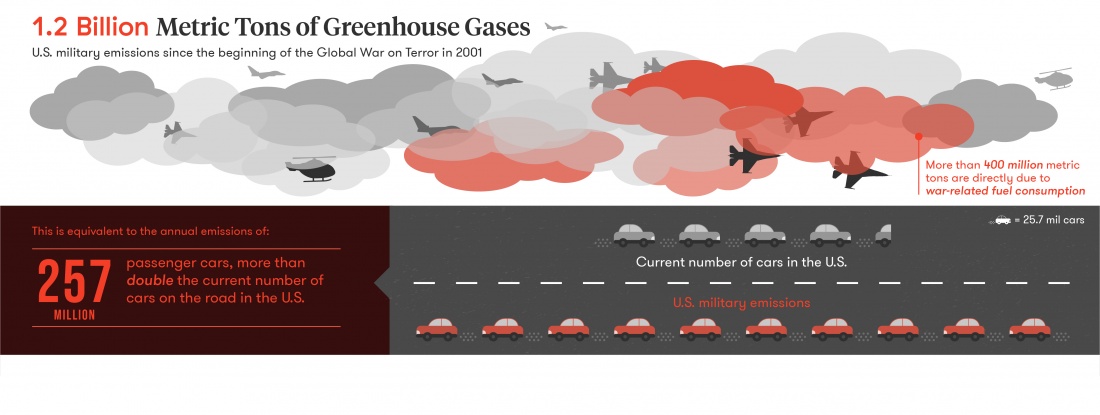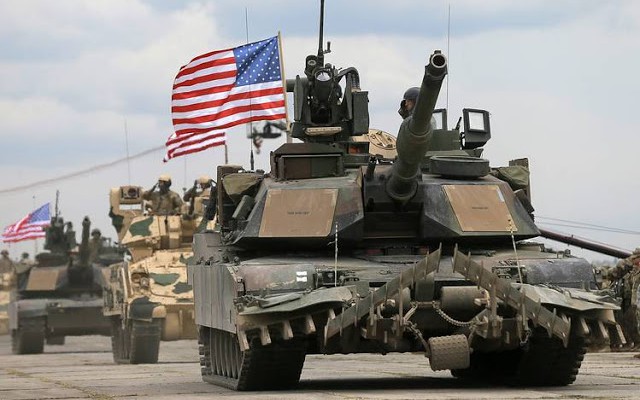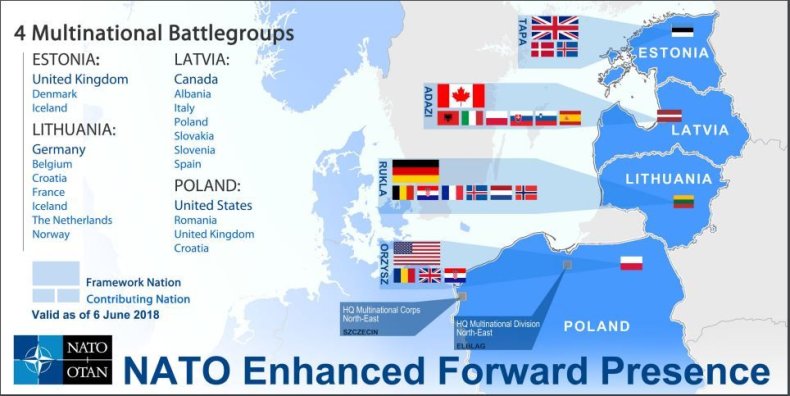NATO: An Unexpected Driver of Climate Action?
Sherri Goodman and Katarina Kertysova / NATO Review
(February 1, 2022) — The recent UN Climate Change Conference (COP26) raised the stakes for global climate action, recognising the urgency of acting today to decarbonise global energy systems. Even so, there have been competing claims about its success, and thousands of youth activists, who gathered in the streets of Glasgow, criticised world leaders and businesses for still failing to recognise the urgency of the climate crisis — the most critical matter of our time. In the fight against climate change, everyone has a part to play. How is NATO, as a security organisation, contributing to international climate efforts and what more can the Alliance do?

A Collective Action Problem
For a long time, environmentalists and the military have seen themselves as miles apart, with little or no interaction. Even today, some green parties in Europe and activists continue to oppose the very existence of armed forces.
In recent years, as the climate movement has accelerated and the awareness of the urgency of climate action has grown, the increasing focus on climate change has also elevated the dialogue on climate security. This, coupled with increasing calls for a more comprehensive approach to address climate change, has gradually brought different sectors together. While the dialogue is not new, the scale and ambition of collective climate action is unprecedented.
Last year’s UN Climate Change Conference (COP26) in Glasgow was a manifestation of the growing willingness to act and work together. Although the Alliance plays no formal role in the UN climate talks, NATO’s Secretary General, Jens Stoltenberg was listed among the Conference participants, alongside other representatives of the defence and security sectors.
Just like his predecessor Anders Fogh Rasmussen, who participated in COP15 in Copenhagen in 2009, Jens Stoltenberg took part in the discussion of climate-related security risks that formed part of the COP26 agenda. Echoing climate-related pledges made at NATO’s Brussels Summit in June last year, Stoltenberg underscored three lines of action that NATO leaders committed to take. In addition to improving their awareness and understanding of the climate-security nexus, the Allies will move towards military emissions reductions and, finally, adapt their forces and operations to changing circumstances so that they can operate in all conditions.
NATO’s Climate Security Agenda
Climate change has long been known as a threat multiplier and is increasingly recognised as a “shaping threat” that dramatically alters the environments in which Allied militaries will have to operate in the coming decades.
From higher frequency and intensity of storms, through extreme heat and cold, to reduced supplies of drinking water and faster wear and tear of military equipment, climate change has significant implications for NATO on the tactical, operational and strategic levels. In addition to climate-related risks to military infrastructure and force readiness, more extreme weather events can also increase conflict and migration potential in and beyond NATO’s immediate neighbourhood.
Born of the Cold War and designed to defend its members against any external aggression, NATO is evolving to reflect the new security reality of actorless threats, such as pandemics, biodiversity loss and climate change.
As a security organisation, NATO cannot be indifferent to these challenges. For NATO to be able to fulfil its core mission of keeping the Euro-Atlantic space safe, building resilience to the impacts of a changing climate and integrating sustainable practices into military planning and capability development is a necessity, not a choice.

Evolving Consensus
The good news is that the Alliance is not starting from scratch. For over 50 years now, NATO has been paying attention to environmental challenges, mostly through a wide range of scientific research activities. NATO has also developed six environmental protection standards (STANAGs) that concern military camps, management of waste, and sustainability of military training areas. Climate change was written into the 2010 Strategic Concept and has been factored into summit declarations since then. In 2014, NATO adopted a Green Defence Framework and integrated energy efficiency and other environmental considerations into the design of the current NATO headquarters, which was completed in 2018. The building blocks for a more ambitious and visible role with respect to climate security are already there.
However, NATO as an alliance of 30 countries works by consensus, which is always evolving. As a former UN Special Envoy on Climate Change, Jens Stoltenberg began advocating for NATO to take greater climate-related action many years ago, but his efforts may have been stymied during the previous U.S. administration. The growing number of climate and weather related disasters, which continue to impact lives and livelihoods both within and outside of NATO’s borders, has marked an evident shift in awareness and acceptance of climate change as an issue of national security across the Alliance. In view of increasing societal pressure and the current political momentum, which includes the renewed U.S. leadership on climate change, NATO is now poised to push a more ambitious climate agenda.

The State of Military Emissions Reporting
COP26 marked the first review of commitments made in Paris in 2015. Despite being a significant source of greenhouse gas emissions, militaries have not been subject to economy-wide emissions reduction targets to date. Except for several Allies (such as France, Germany, the Netherlands, the UK, and the US) that already produce such estimates, military emissions are neither measured, nor reported — either due to a lack of data or because military emissions are treated as sensitive information. Even where military emissions are measured, the metrics are not consistent across the board.
NATO can support Allies in their emissions reduction and adaptation efforts by setting net zero and sustainable targets for defence planning, shifting away from its single fuel policy towards more sustainable alternatives, or through different standardization agreements, as described below. The Alliance is set to develop a methodology to help Allies measure their military emissions and, in the next step, formulate voluntary goals for their reduction.

NATO’s Value Added
In addition to supporting Allies in their emissions reduction and adaptation efforts, NATO has several important assets (in comparison to other international organisations) through which it can make useful contributions to international climate efforts.
One of NATO’s biggest assets is its network of partners across the globe and structured relations with other regional and international organisations, including the United Nations (UN), the European Union (EU) and the Organization for Security and Co-operation in Europe (OSCE). This network is crucial both for capacity- and resilience-building and improved situational awareness.
Second, NATO provides a platform where Allies can come together to exchange expertise, best practices and lessons learned — almost on a daily basis. The sharing of lessons learned is important for militaries to better understand the benefits of green transition. In addition, the planned NATO accredited Centre of Excellence on Climate and Security (which Canada has offered to host) and the existing Centre on Energy Security, located in Lithuania, will certainly have roles as clearinghouses for information on both climate impacts and the green transition.
Third, climate change is increasing the demand for Allied militaries to provide humanitarian assistance and natural disaster response. NATO nations have already been engaged in many such missions, from Northern Iraq in 1991 to Pakistan and the U.S. after Hurricane Katrina in 2005. Over the last several decades, NATO has deepened its experience in responding to humanitarian crises and natural disasters. Now, the Alliance can use its planning and preparedness capabilities to address the effects of climate-fuelled events, from heatwaves to flooding.
And, finally, NATO has a long and successful track-record as a standard setter. Through the standardization agreements (STANAGs), NATO can set standards not only on how Allied militaries operate but also what type of equipment they operate. As such, the Alliance can lead the way in building the resilience of NATO bases and operations, help Allies harden their forces to climate impacts, and ensure that military equipment is not only climate-friendly but also effective under extreme weather conditions.
NATO can also take the lead in guiding the way forward on research and development of alternative fuels and propulsion systems for military applications. This would ensure that NATO forces continue to remain interoperable.
In turn, NATO’s climate standards can translate into buying power and market making opportunities. The so-called white fleet, which comprises vehicles that are used for administrative and non-operational purposes is a promising place to start. By electrifying their white fleets, Allied militaries would create the need for more charging stations and supporting infrastructure to be built, which can benefit society as a whole. As early adopters, Allied militaries can further advance societal change.

From Consequence Management to Prevention
The Alliance is already coping with the consequences of environmental change. While maintaining the ability to respond to natural disasters and training for crisis management scenarios is important, NATO needs to shift to prevention and preparedness.
Addressing root causes will require NATO to improve its early warning, early action and strategic foresight capabilities. Early warning tools are currently not interoperable across diplomatic, defense and development communities (known as the “3Ds”), which adds to the challenge. Their integration will be an important step forward.
In addition to integrating data analytics in a more interoperable way, environmental and ecological concerns should be incorporated into Allied intelligence assessments — all while making intelligence more anticipatory. This would help to increase NATO’s capacity to forecast future environmental shocks and be prepared to respond in time.

Greener Means Stronger
Contrary to popular belief, there is no contradiction between NATO’s “greening” efforts and the Alliance’s ability to effectively deter and defend. In fact, emissions reductions, coupled with green technologies, offer operational advantages. These include lower dependence on fossil fuel supplies in areas of high insecurity, reduced logistical challenges, or financial savings.
The American B-52 engine replacement programme, for instance, will reduce fuel burn and lower the overall environmental impact all while enhancing aircraft range and endurance. Just as the business world has come to realise that protecting the environment and tackling climate pollution is not at odds with economic growth, but in fact is necessary to ensure there is any future world in which to build an economy, the security world needs to appreciate that environmental sustainability and resilience is part of ensuring operational reach and effectiveness.

Conclusion
Climate change is a threat multiplier and an existential danger to Allied populations. The NATO 2030 Young Leaders Group concluded in early 2021 that, in order to fulfil its core mission of keeping the Euro-Atlantic space safe and free, NATO needs to “understand the conflict and instability implications of climate change, better prepare for future shocks, adapt its forces to extreme circumstances and reduce its own ecological footprint.”
Raising not just ambition but also action will require steady leadership toward building political consensus, as well as the alignment of the civilian and military sides of the Alliance. With the Madrid summit on the horizon, NATO should leverage more than 50 years of experience dealing with environmental challenges, demonstrate it can lead by example on climate security and that it is a sustainable force for the future.
Sherri Goodman is the Secretary General of the International Military Council on Climate & Security. She is the former US Deputy Under Secretary of Defense (Environmental Security). Senior Fellow, Wilson Center.
Katarina Kertysova is a Policy Fellow at the European Leadership Network (ELN) and a Wilson Centre Global Fellow. She is a member of the NATO 2030 Young Leaders Group.
What is published in NATO Review does not constitute the official position or policy of NATO or member governments. NATO Review seeks to inform and promote debate on security issues. The views expressed by authors are their own.
Posted in accordance with Title 17, Section 107, US Code, for noncommercial, educational purposes.
